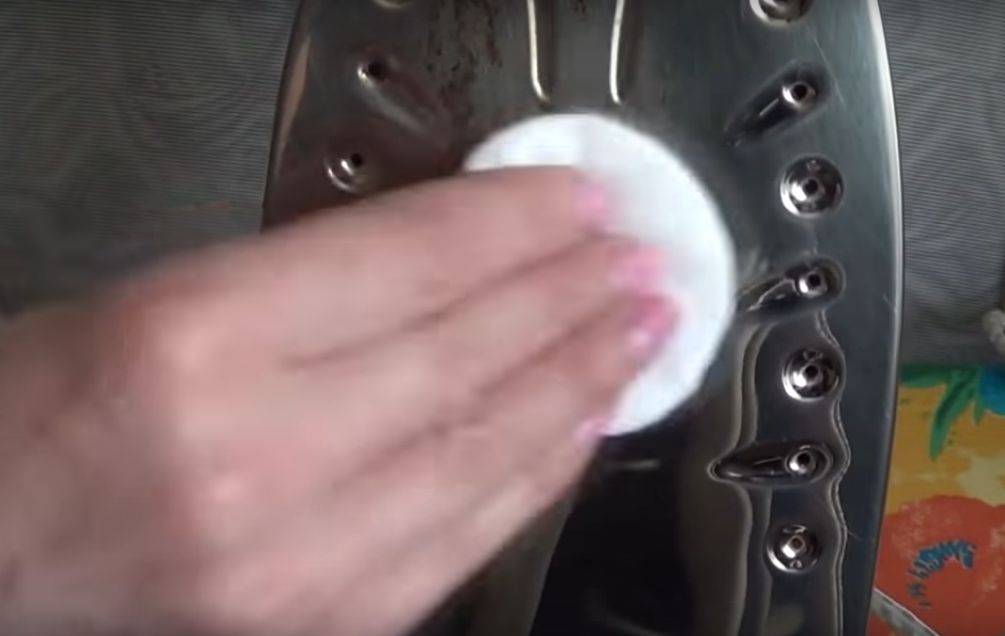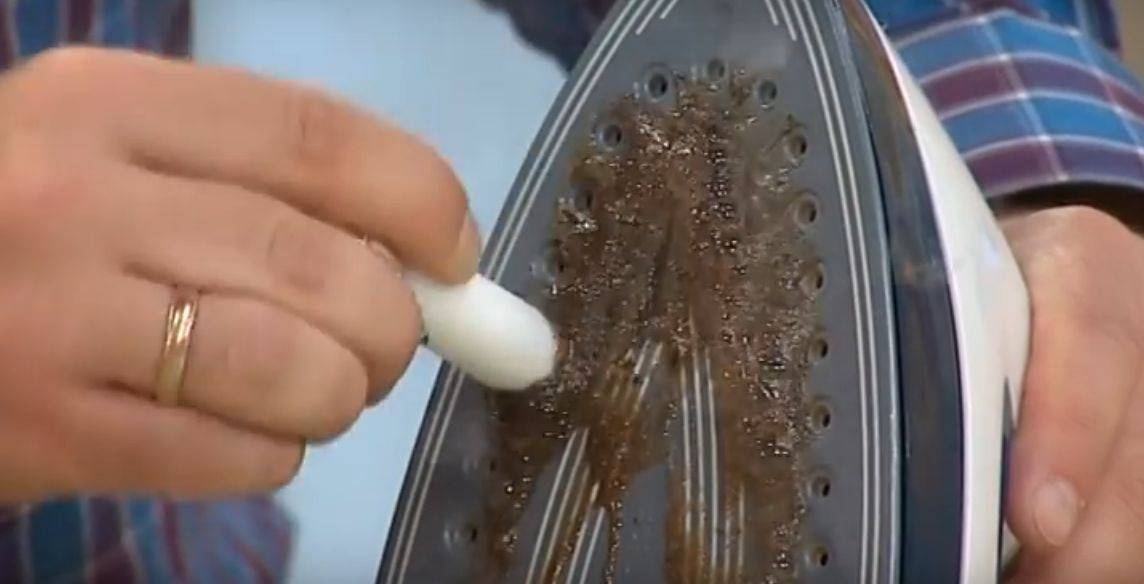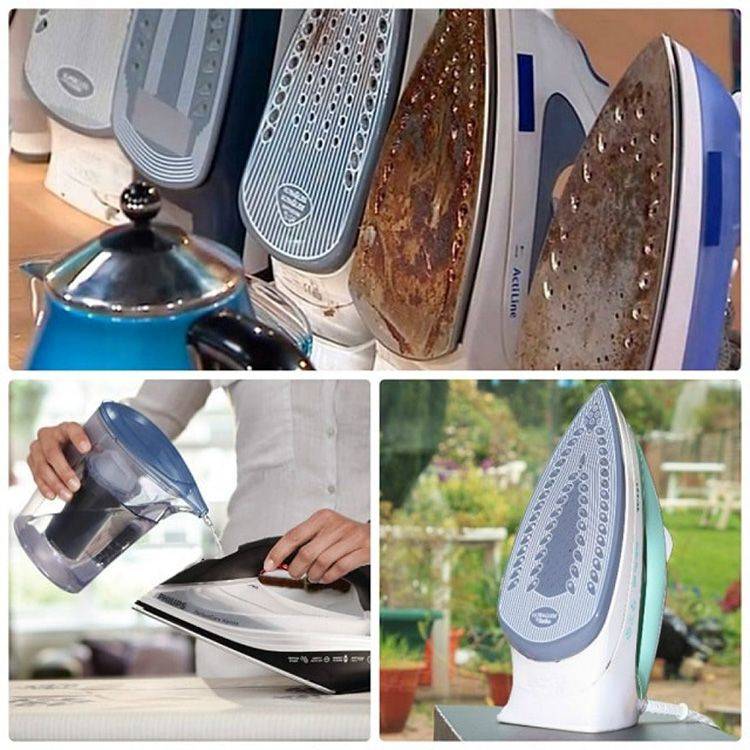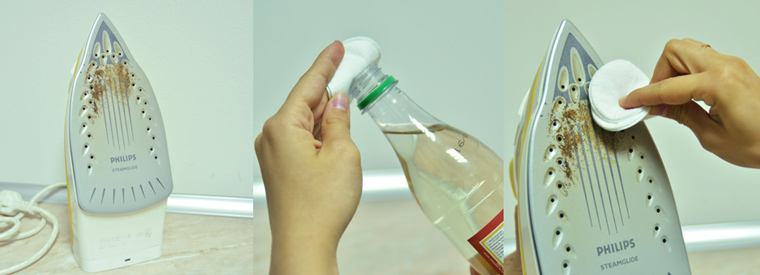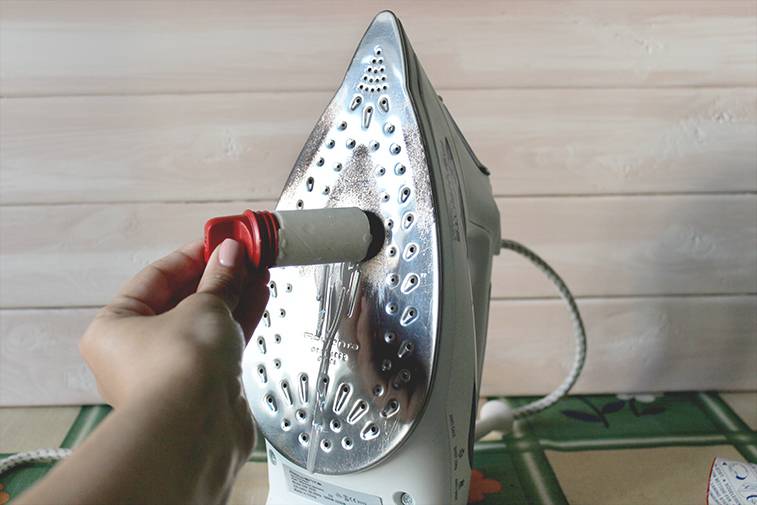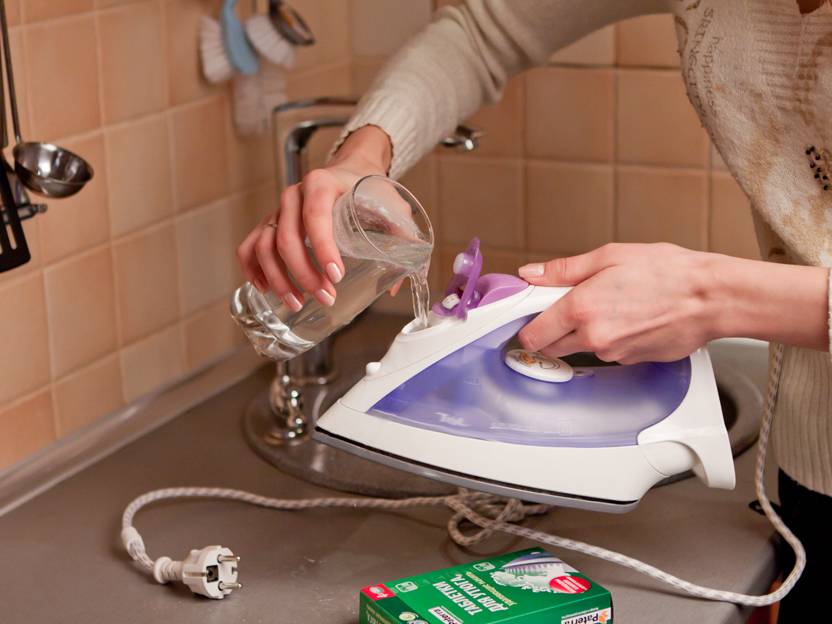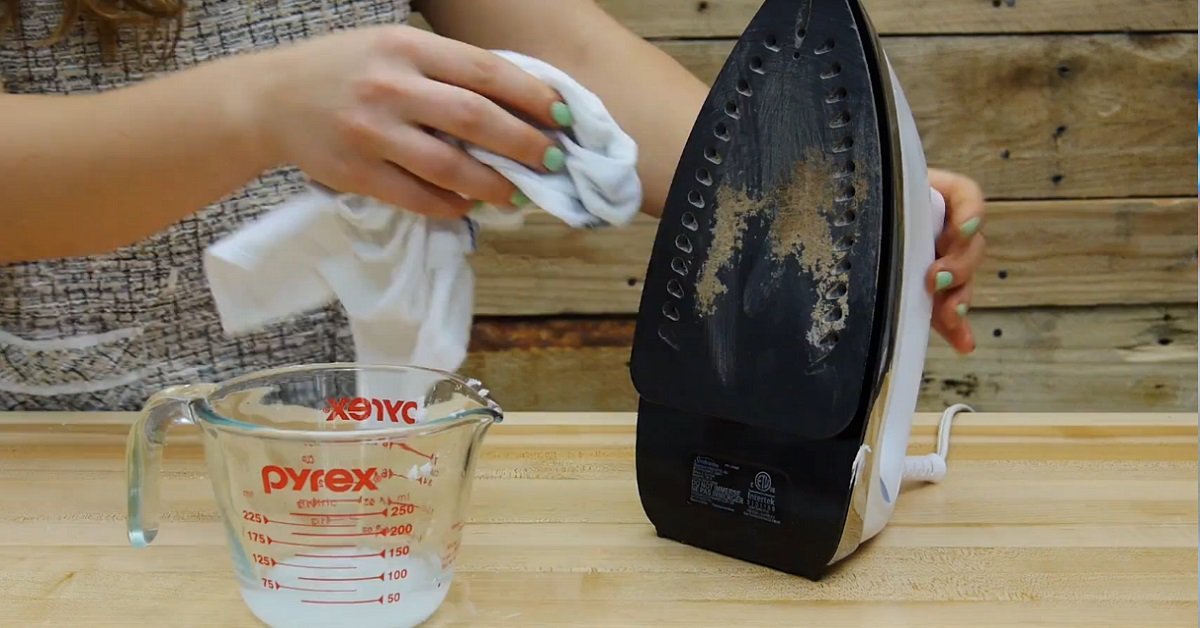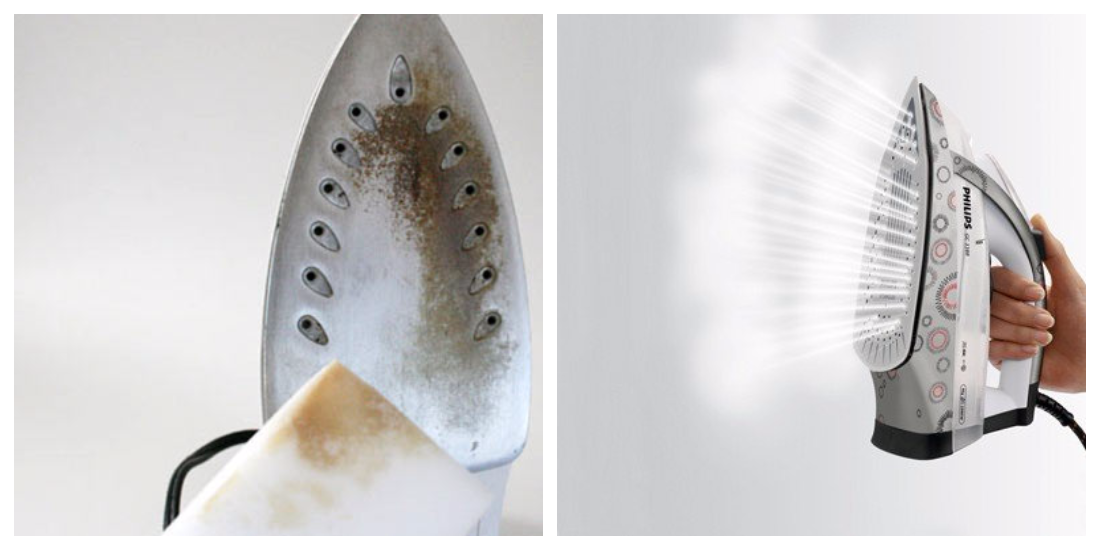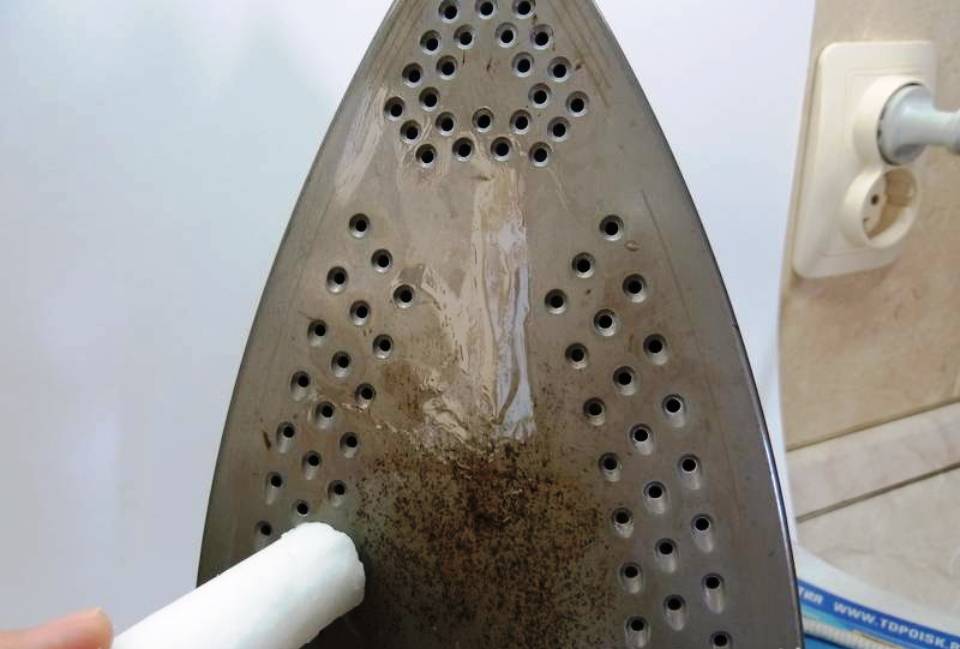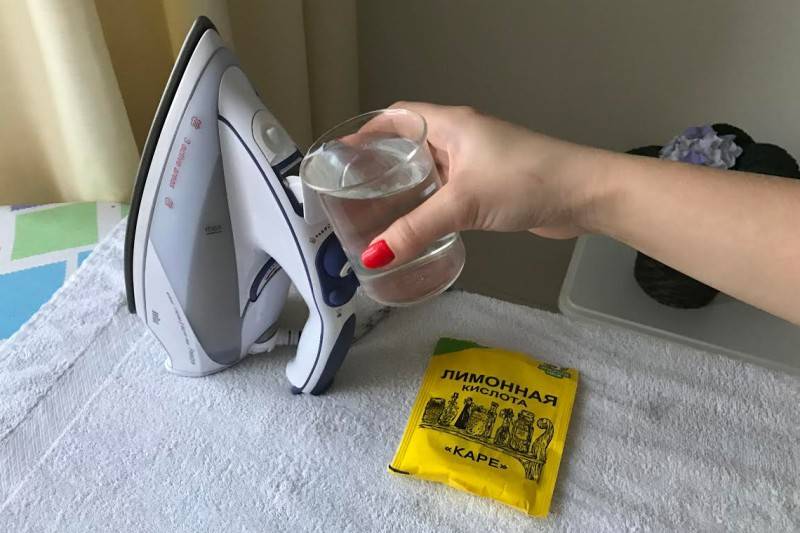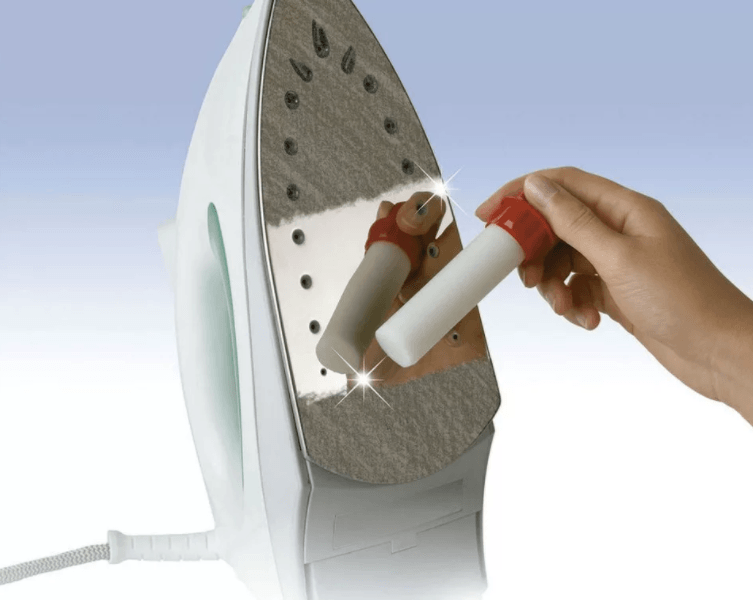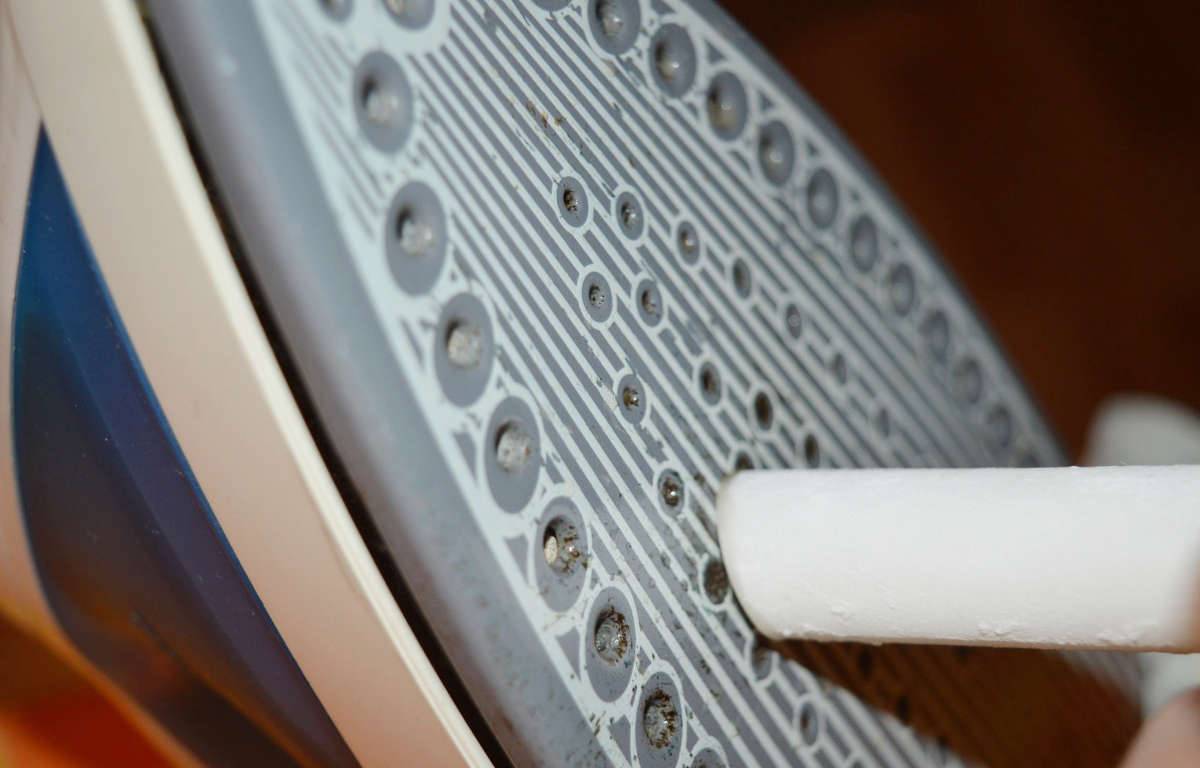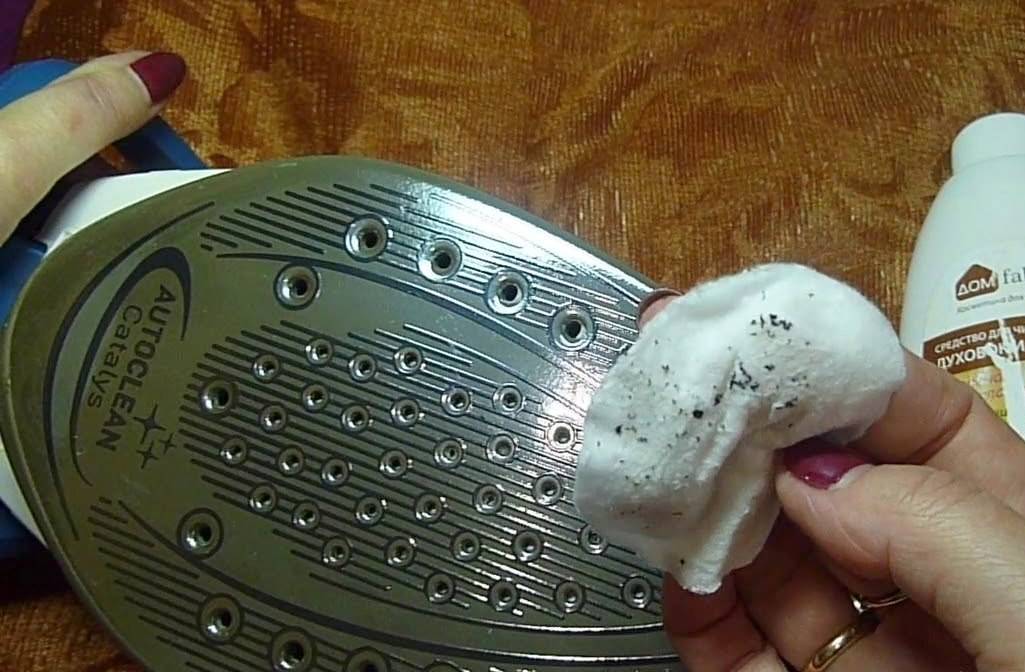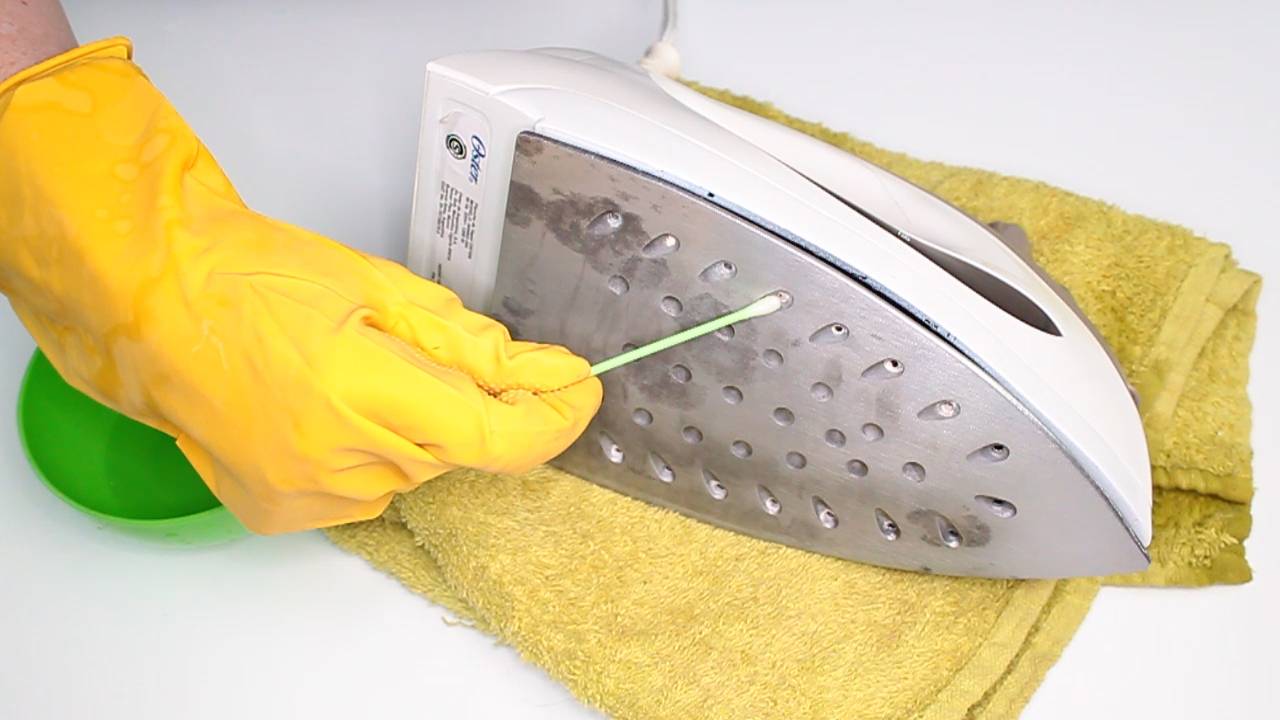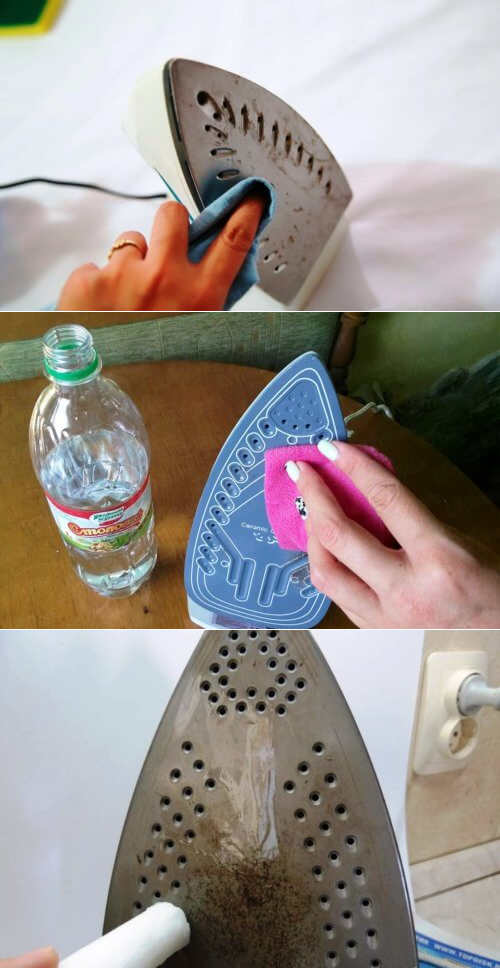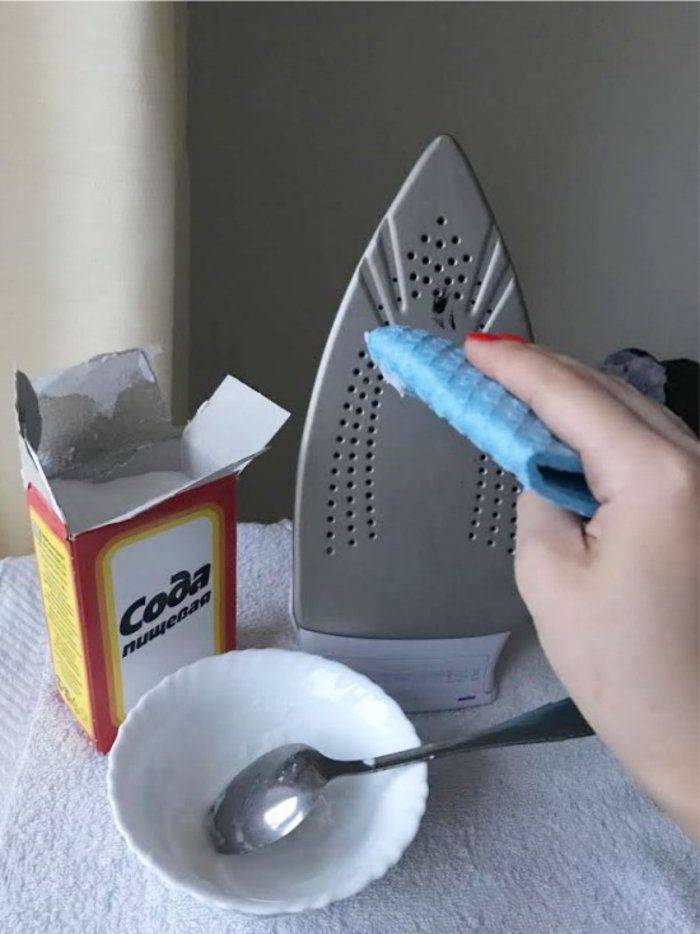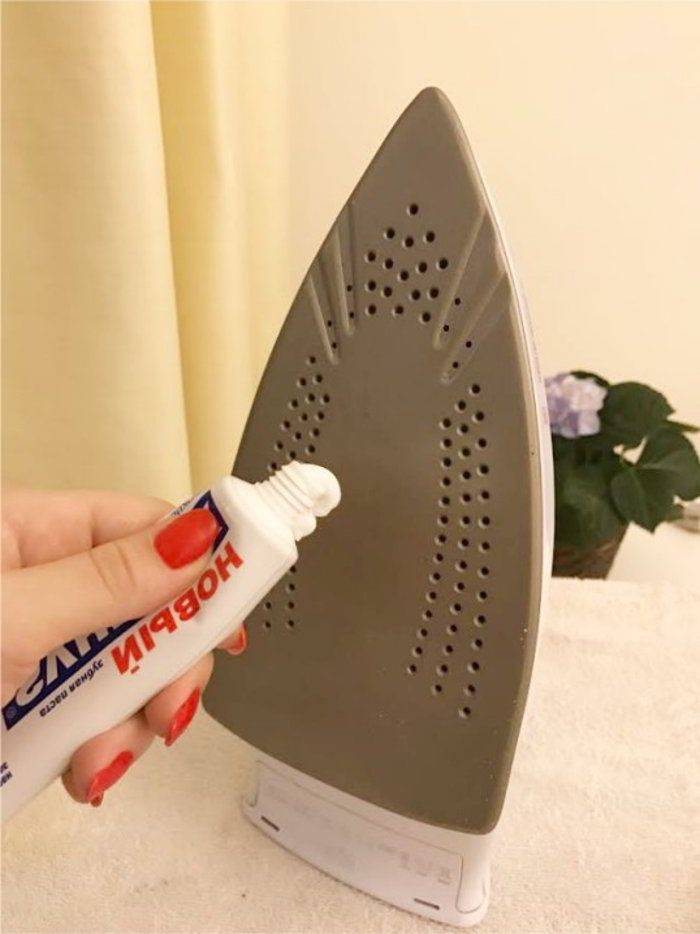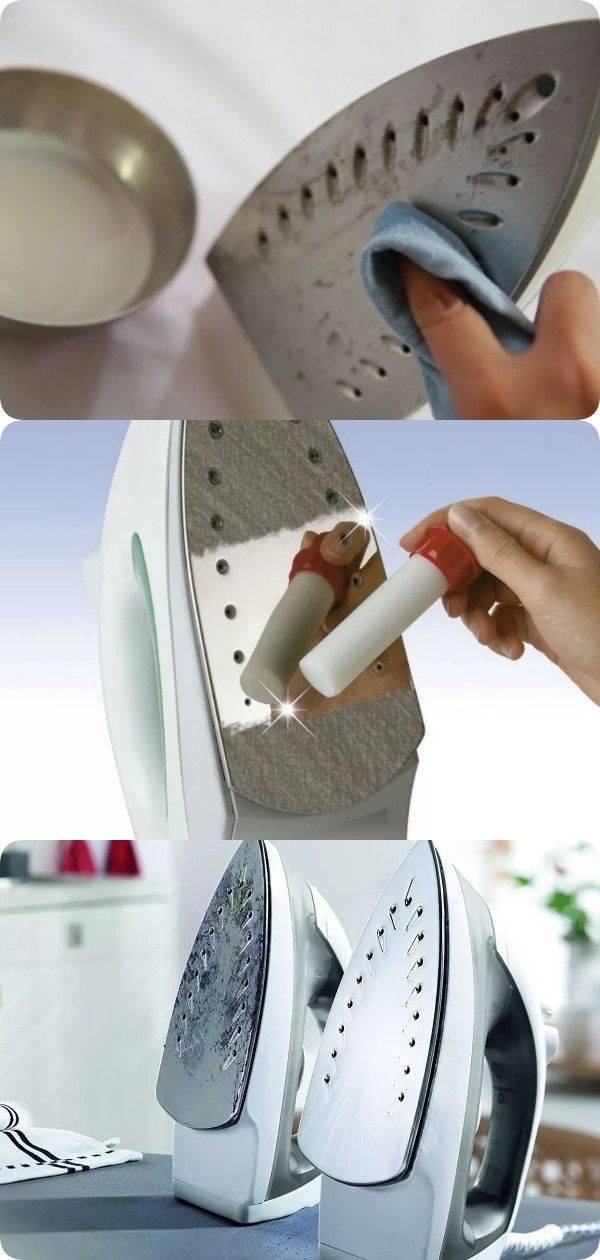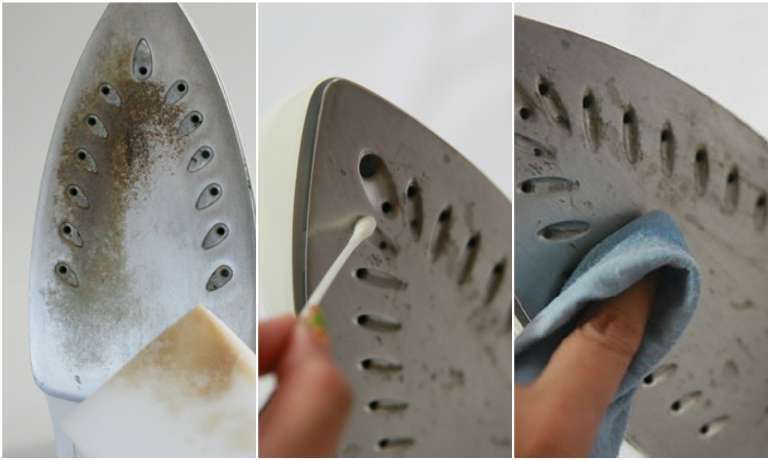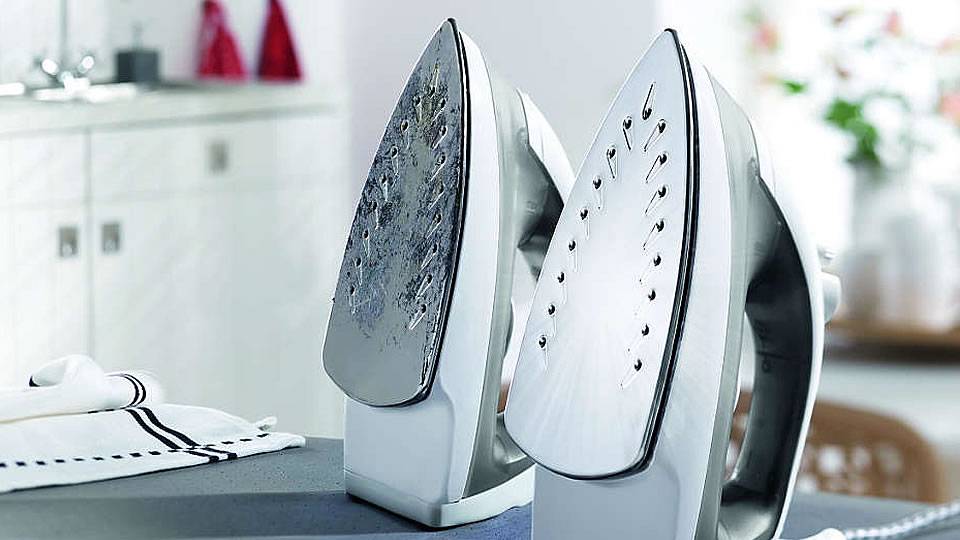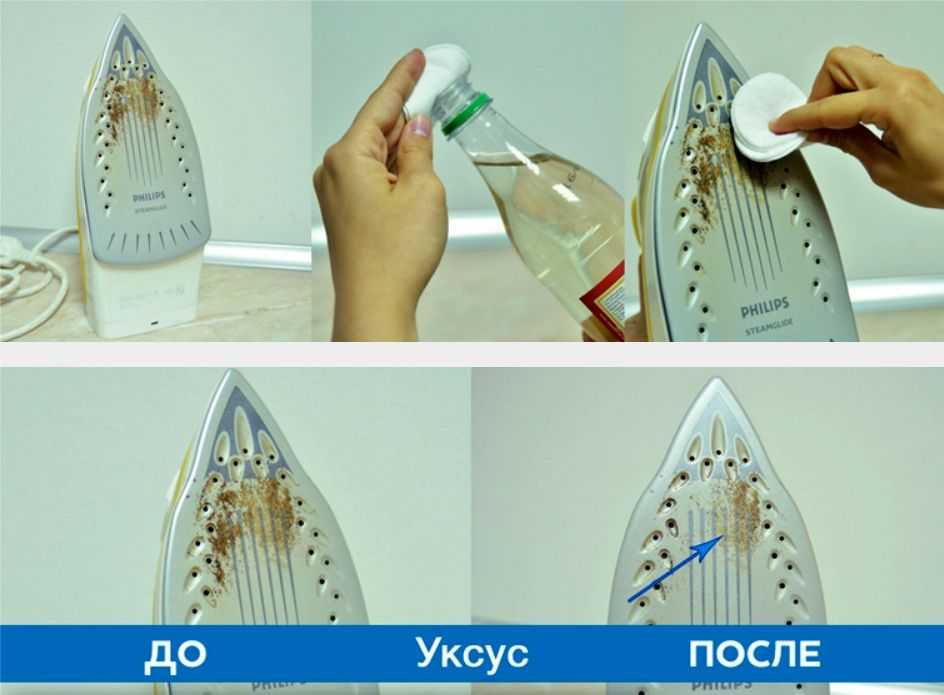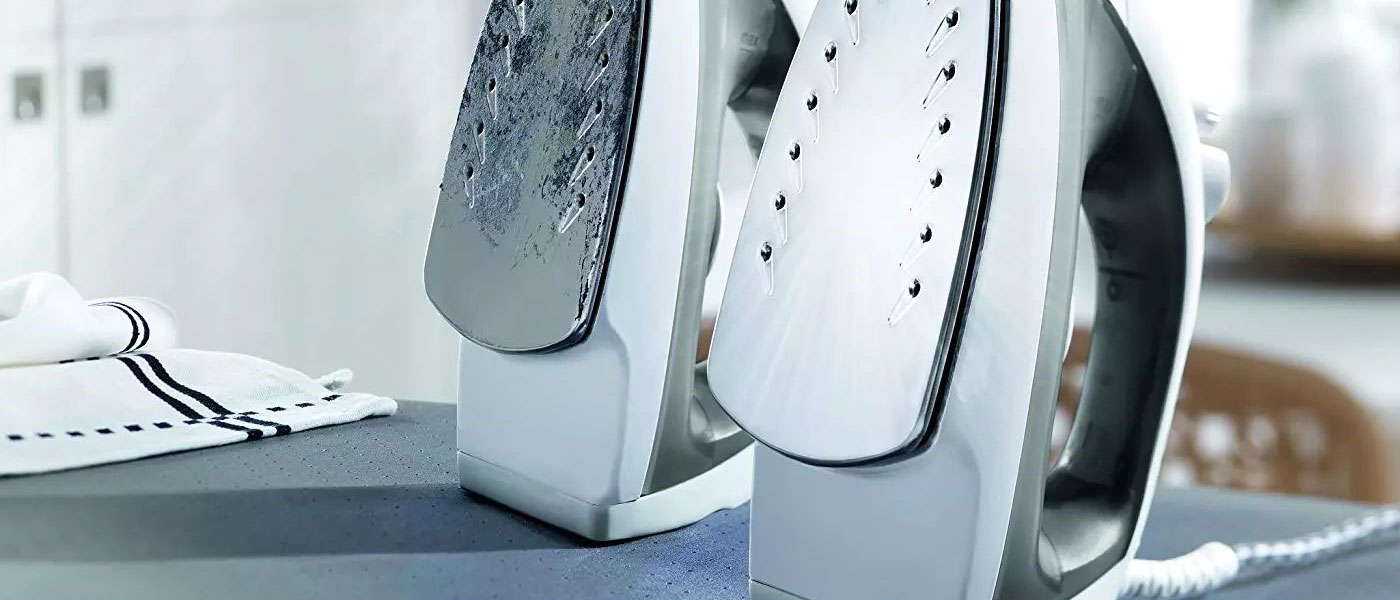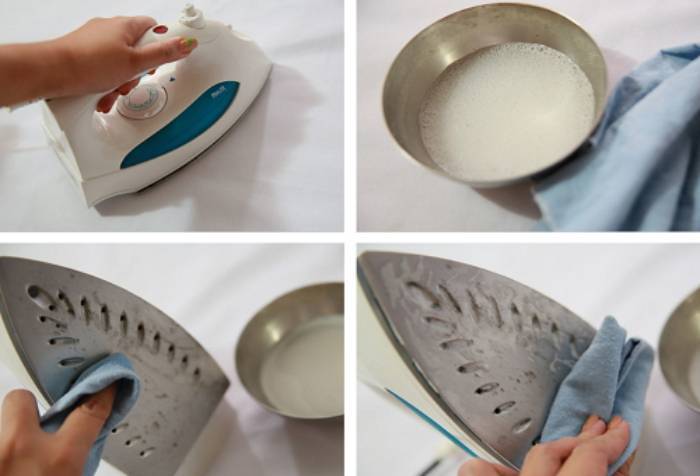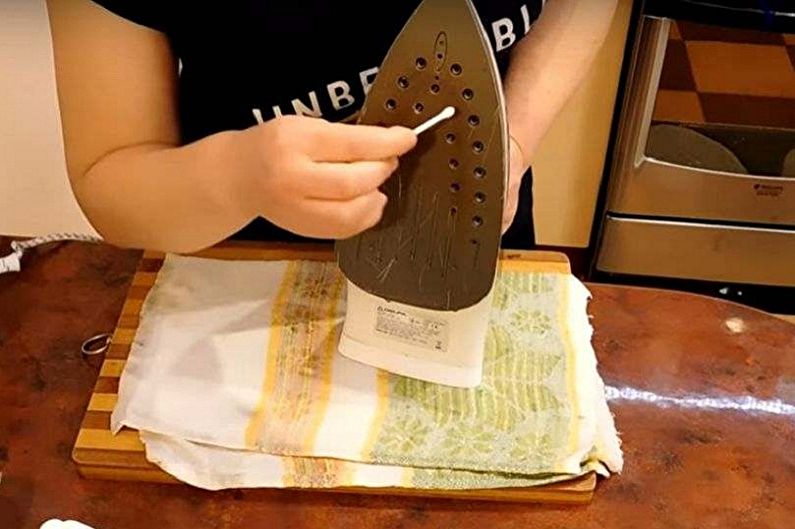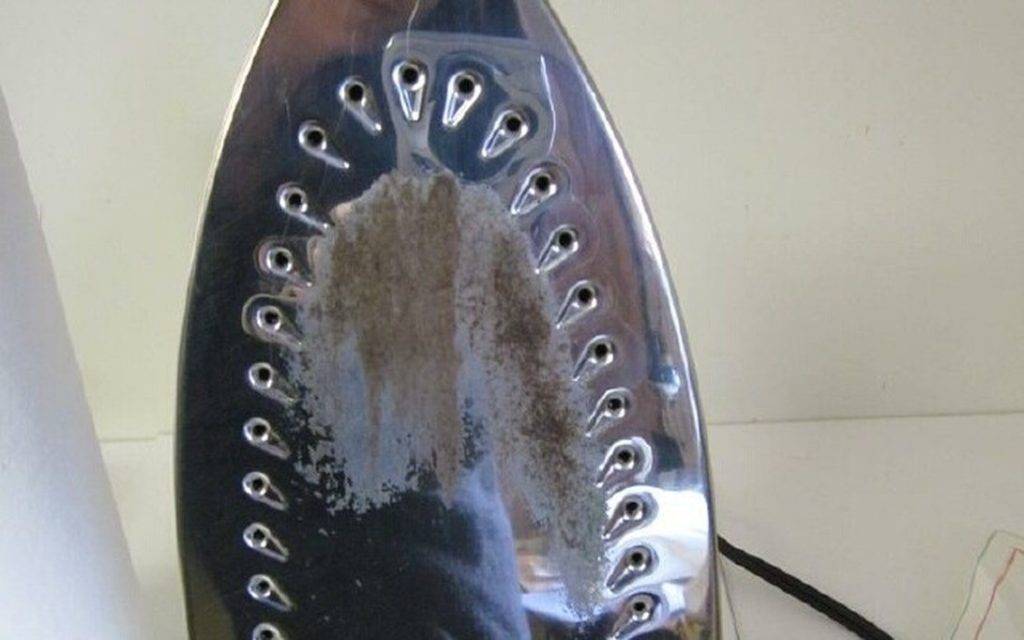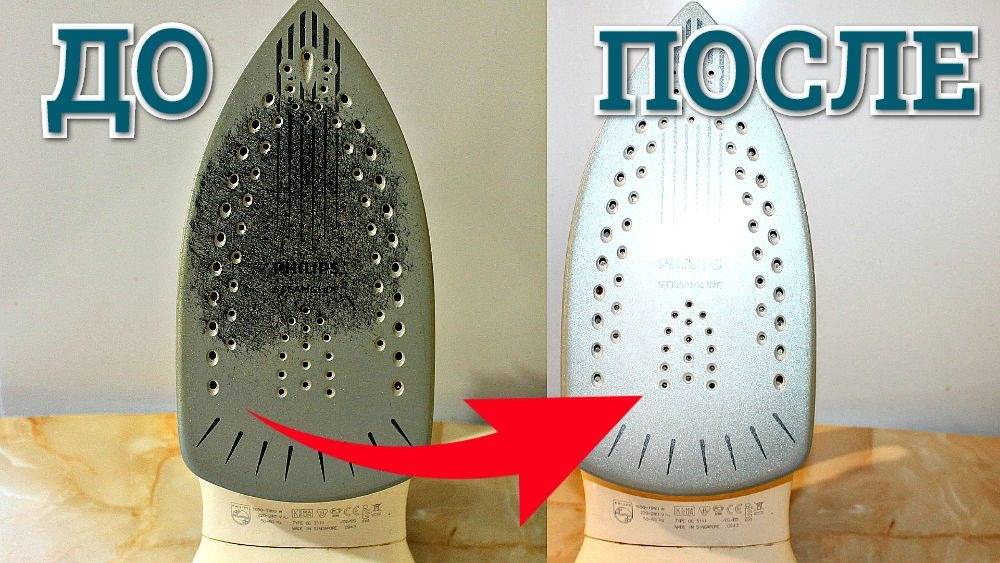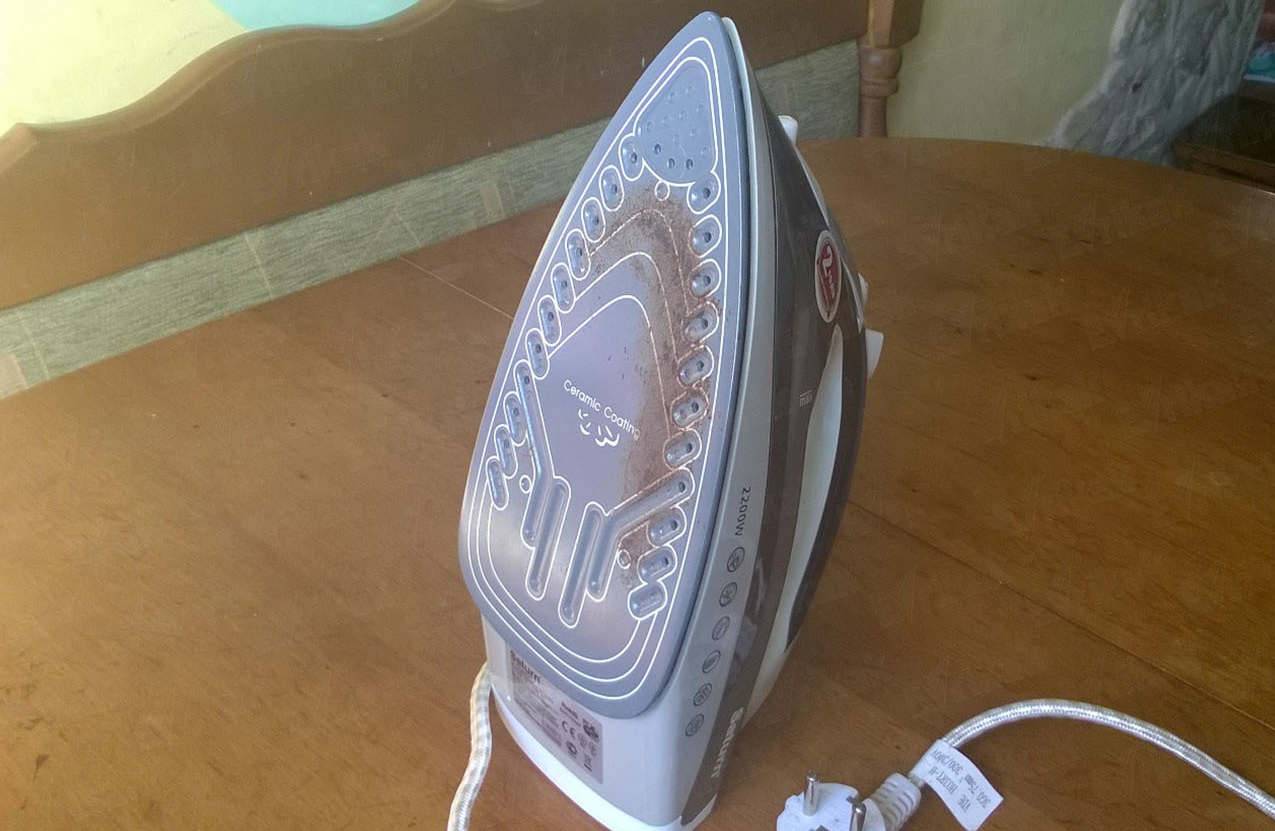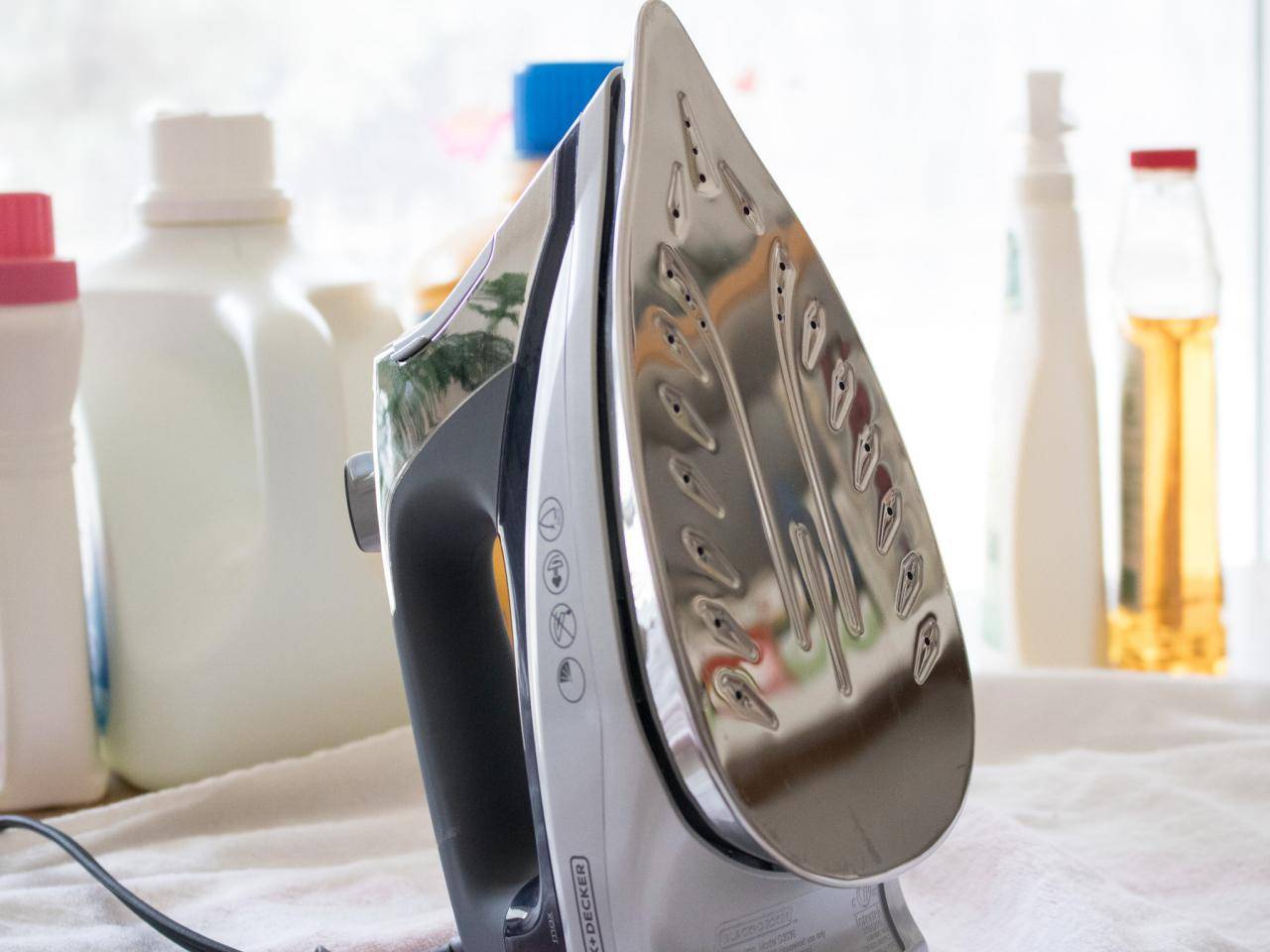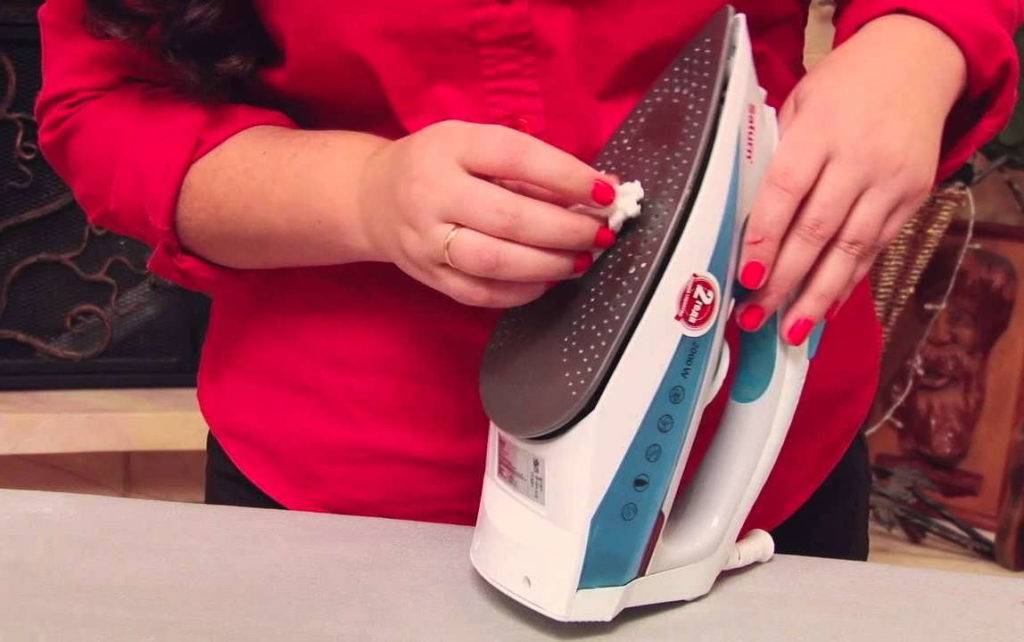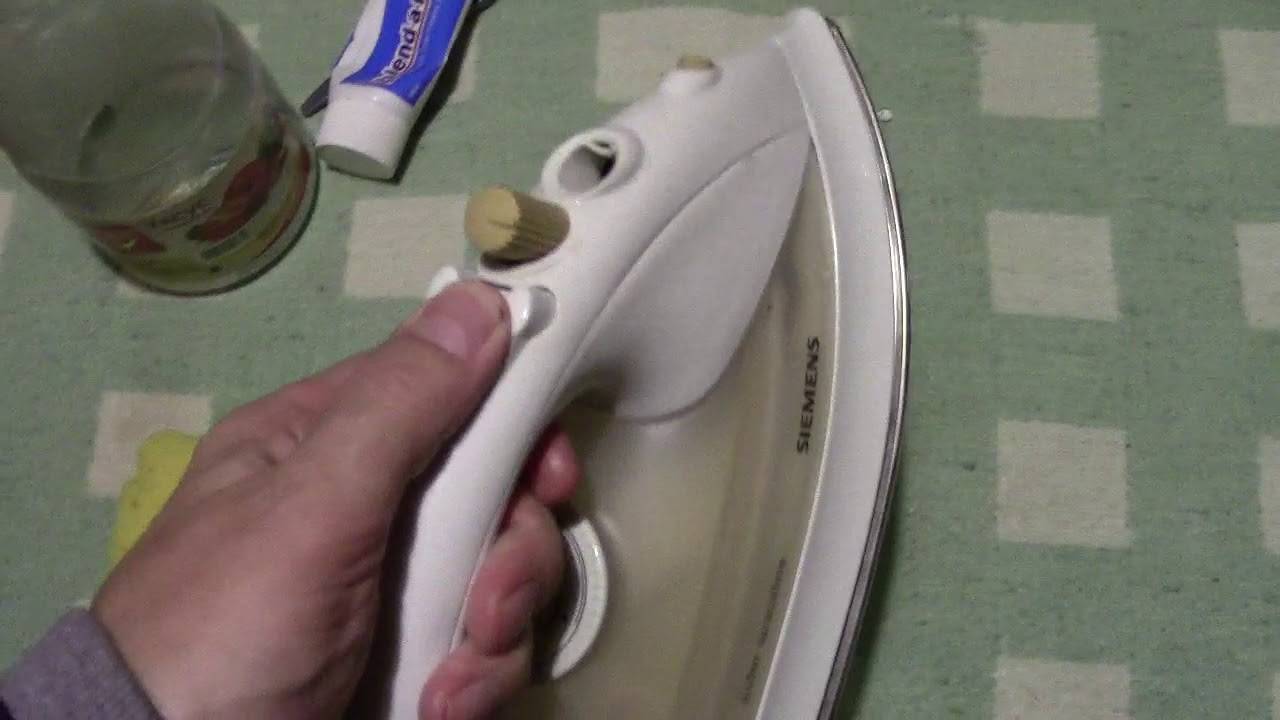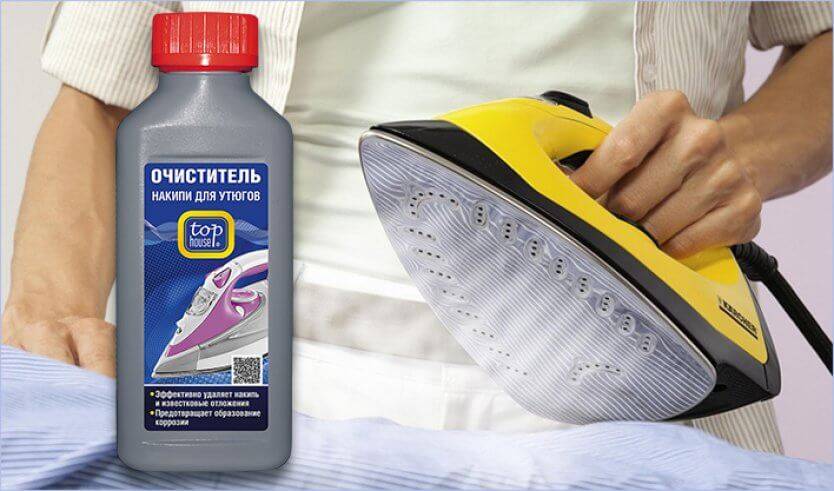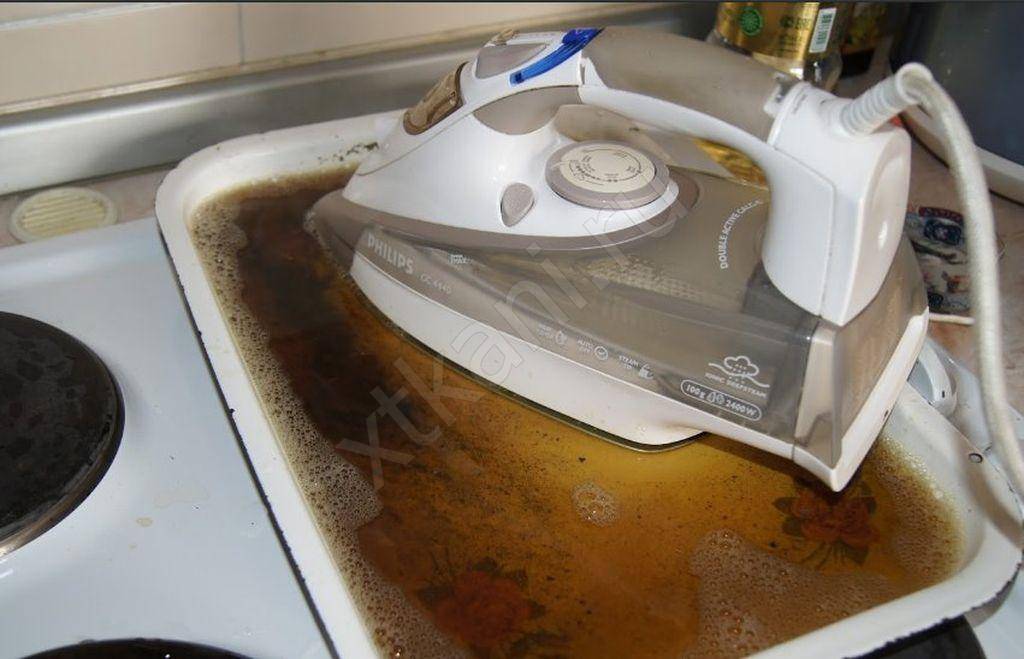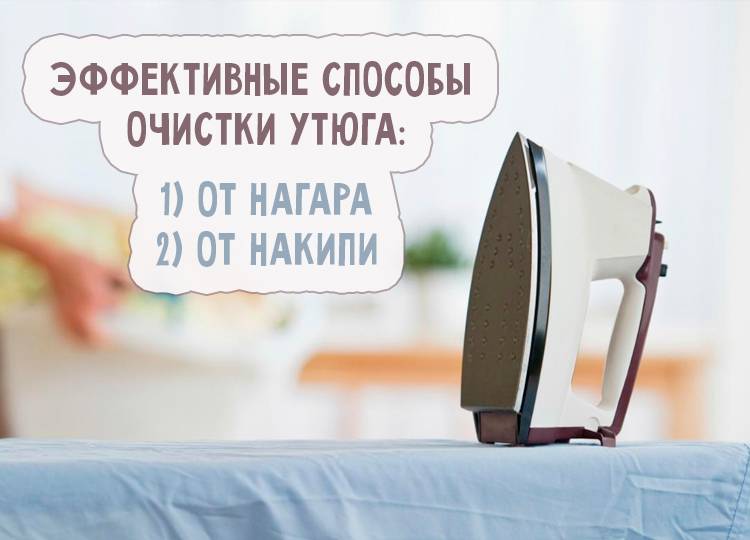How to descale the inside
Permanent deposits on the sides of the water tank make splashing difficult and reduce the ironing quality. In addition, the water can become dirty and leave streaks or stains on the fabric. Many women's magazines publish tips on how to descale your iron. It is worth listening to the opinion of experienced housewives who have tested many methods and made a choice in favor of the most effective ones.
1The simplest option is to use the self-cleaning function found on most modern steam models. You need to fill the water tank to the top and turn on the device at maximum power. After heating, the iron turns off and on again. After re-disconnecting, you need to press the purge button on the body of the device and hold the iron over the basin. Dirty water will pour out of the appliance
You can shake the iron vigorously to clean the container better.
It is important to be careful not to scald your hands with boiling water and steam. After the end of the cycle, you need to cool the device and wipe the surface, removing traces of plaque. Such treatment can be carried out once every 2 months, the manufacturer gives precise recommendations, they are indicated in the instructions.
2 Perfectly cleans the reservoir and steam holes citric acid
A bag of 25 g is dissolved in a glass of water, the mixture is poured into the tank
The iron heats up, after that you need to press the steam release button. It is better to hold the device over a basin or other container, dirty water will pour out of it. After the tank is completely emptied, the procedure is repeated, but clean water is poured into the device. After processing, the sole must be thoroughly wiped. First, it is treated with a rag dipped in vinegar, then washed with clean water and wiped dry.
3 A smart solution is to use carbonated water to clean the tank. The acids contained in it dissolve scale perfectly. After the end of the cycle, the tank must be rinsed with clean water, and the soles must be wiped with a clean sponge.
Deciding what to clean your iron is not easy. If in doubt, it is best to try your chosen remedy on a small area. If you succeed, you can safely clean the entire sole. You should not abuse cleaning agents, it is much more important to protect the iron from carbon deposits, lime complications and damage. With careful and attentive care, it will work flawlessly, quickly and accurately bringing the laundry to perfect condition.
Aspirin and dishwashing detergent
Aspirin or acetylsalicylic acid, it turns out, is successfully used not only for medicinal purposes, but also as a means for descaling household appliances.
- Prepare a package of aspirin tablets, crush them to a powder and pour into a small container.
- Add a few drops of dish soap to the powder. You can also use liquid soap instead.
- Add a little water, stir everything well.
- Pour the resulting mixture into a container for water and use as in the previous recipes.
If cleaning is not very successful, then repeat the procedure. Finally, rinse the iron system thoroughly with water.
Soda, citric and acetic acid
If significant scale deposits have accumulated on the walls of the iron container, you can use complex cleaning.
For the procedure, prepare soda, citric and acetic acid. This cleaning will take a long time.
- First, prepare a soda solution: dissolve a tablespoon of soda in a glass of warm filtered water. Pour the solution into a water tank and turn on the iron for 20 minutes at the optimum temperature.
- Then activate the steaming mode by pressing the button, placing a basin under the appliance.Soda solution with steam and pieces of limescale will come out through the holes in the sole.
- Then do the same using a citric acid solution. To do this, dissolve 25 grams of acid in a cup of water.
- Finish cleaning with acetic acid. To do this, mix equal proportions of acetic acid and water in a glass of water. After cleaning the iron three times, it remains to rinse the electrical appliance system with water.
How to descale the iron inside
Scale forms due to the presence of magnesium and calcium salts in the water poured into the iron reservoir. When heated, they precipitate into an insoluble precipitate. As a result, the inside of the holes in the sole are covered with orange-brown particles, which leads to difficulty in vapor escape and the formation of stains on the fabric.
To clean the iron from scale, you should pay attention to the methods with citric acid, vinegar and special means.
Lemon acid
Algorithm of actions:
- Prepare a solution of 200 ml boiling water and 1 teaspoon of citric acid.
- Pour it into the iron reservoir. Switch on the device by selecting the mode with the highest temperature.
- Disconnect the heated iron from the mains.
- Holding the iron over a bathtub, sink or special container, press the "Steaming" button several times.
- Pour the remaining solution out of the reservoir.
- Pour in clean water. Repeat all manipulations. Wipe the sole with a rag.
If limescale remains in the holes of the soleplate, you can reuse the citric acid solution. Soak gauze in it and put the iron on it for 5-10 minutes. Then it needs to be heated and ironed with a cloth.
Cillit
In search of a solution to how you can still clean this household appliance, it makes sense to use Cillit. You should take a product designed to combat limescale.
Stages:
- Heat the iron. Turn it off.
- Position the appliance so that the sole is horizontal at the top.
- Pour a small amount of the product into each hole.
- After 7-10 minutes, when rust appears, wipe it off with a damp sponge.
- Pour water into the tank. After the iron has warmed up, activate the steaming mode several times. Wipe the surface with a cloth.
Special means
To remove the build-up, you can resort to using a special tool - a decalcifier, designed to combat limescale that forms in household appliances. One of these drugs is "Antinakipin". Cleaning scheme:
- Dilute the product with water in a proportion of 2 tablespoons per glass. Pour liquid into the reservoir of the device.
- Heat the iron and leave for 30 minutes.
- Heat the device again. Press the "Steam" button several times.
- Rinse the reservoir thoroughly. Dry the iron with a dry towel.
If you need to regularly descale the steam generator, you can use both domestic and industrial products.
Boiling with vinegar
This option to wash off scale involves boiling in a vinegar solution. Stages of work:
- Take a heat-resistant container with low sides. Place the iron horizontally in it. Do not connect it to the network.
- Set the steam regulator to maximum. Place wooden sticks under the appliance in the front and back, so that the sole does not touch the container.
- Combine 1 liter of water and 0.2 liter of vinegar. Pour into a container. Water can cover the working surface of the iron no more than 1 cm in height. The plastic and electrical parts of the appliance must not get wet.
- Place the container on low heat. Boil for 10 minutes. This will clean the holes with the steam and vinegar.
- Turn off the fire. After the water has cooled, heat it up again and let it boil for another 10 minutes.
- Remove the iron from the container. Rinse the sole under running water. Place the appliance upright so that it dries on its own within 24 hours.
What can happen to the iron: a list of common problems
- 1 At home, irons most often suffer from the wrong choice of temperature.Excessively hot outsole melts synthetic fibers, which adhere firmly to the surface.
- 2 The iron can also be damaged due to contact with buttons, elastic inserts, plastic buttons. Hard materials scratch the surface, plastic melts quickly and sticks to the sole.
- 3Another problem is the hard chlorinated water that is poured into the humidifier reservoir. When boiling, limescale remains on the walls, after each use, its layer thickens. The unfortunate result can be clogging of the spray arm, after which the iron can no longer generate steam.
- 4Sometimes the iron deteriorates from the carelessness of the owners. For example, an appliance that has not yet cooled down may fall onto a carpet or plastic countertop. If dropped from a low height, the case will not be damaged, but synthetic fibers or melted plastic will hopelessly ruin the sole.
For prevention, you must carefully follow the operating rules described in detail in the instructions.
Before ironing, it is important to find out the composition of the fabric and set the desired temperature.
Special care must be taken at the beginning of the process when the iron is heating up. After the laundry has been ironed, the iron should cool down on a special stand that prevents it from falling
When the surface becomes cold, wipe it with a soft cloth and put the device in storage.
After the laundry has been ironed, the iron should cool down on a special stand that prevents it from falling. When the surface becomes cold, wipe it with a soft cloth and store the device.
To reduce scale build-up, it is best to use clean bottled drinking water or special iron water available from hardware stores. After the end of ironing, the remaining liquid is drained.
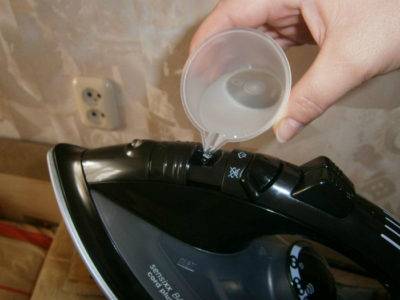
Removing scale inside
Almost all irons now come with steam - they are more convenient and efficient. During operation, scale forms inside - these are insoluble substances that water contains. They are present if non-distilled water is poured into the iron. If the iron has a self-cleaning function, turn it on periodically. If not, you will have to act differently.
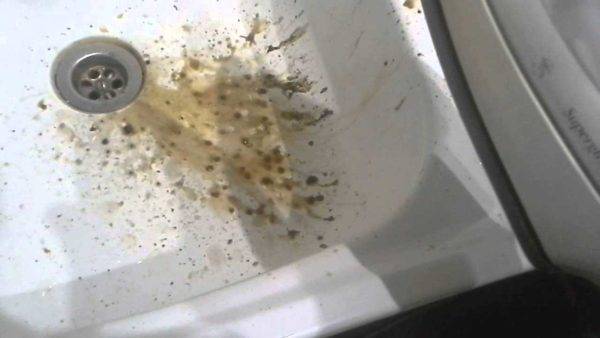
This is what was inside the steam iron
Cleaning from the inside
To remove scale in the iron, pour acidified water inside. Scale is salts, the acidic environment eats them away, they loosen and come out with steam. It is better to take water as purified as possible. Better - distilled. If it is not available - boiled or after good cleaning. Add citric acid to the water. For 200 ml - about 25 grams, for a liter - 5-6 tablespoons. You can also pour alcohol vinegar (one glass of 9% per liter), but it has a more unpleasant smell.
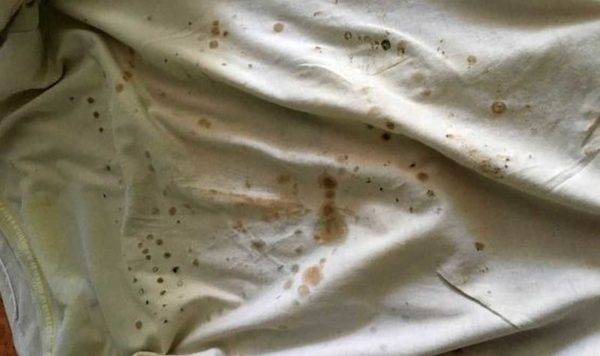
In order to clean the inside of the iron, you need to pour water with citric acid and turn it on before heating. And this is what pours out from there
Pour the acidified water into the iron reservoir. In terms of quantity - to the maximum. We turn on the iron to the maximum temperature. We heat until the light goes out twice or three times. Turn off the iron, go to the sink. We are good cowardly, letting off steam. If it has cooled down, and there is still water inside, we heat it up again, turn it off and continue cleaning.
The final stage is to pour in clean water and "evaporate" all of it. You can do this over an old rag for impressions. Usually, after observing what has accumulated inside, they rarely forget to clean the iron.
Boiling
The same composition (water with vinegar or citric acid) is poured into a baking sheet with high sides. We put two sticks on the bottom (you can make sushi, you can just chips). The purpose of the sticks is to provide a gap between the baking sheet and the soleplate of the iron.
We put a cold iron in a container on pieces of wood. The liquid level should be such that it covers the sole but does not reach the plastic parts. We put all this on the burner, bring to a boil, leave to cool. Heat it up again, cool it down. So 2-4 times. Next, you need to drain the water that got inside the iron through the steam holes.You can drain it through the filler hole. The water will not be clean, usually yellow with limescale residues.

Don't know how to descale the iron inside? Water with citric acid
Pour clean water inside the iron, rinse and pour out. Then you need to leave it alone until it dries. After a couple of hours, you can turn on and try to iron.
Products for ceramics and teflon
You should be aware that ceramic and Teflon soles are cleaned in about the same way with some nuances. Among folk remedies, the following are used:
- Hydrogen peroxide. Take a cotton pad and water it liberally with hydrogen peroxide, and then gently clean the soleplate. During this procedure, it is not necessary to heat the device, since carbon deposits are perfectly removed from a cold surface.
- Hydroperite tablets. Rubbing the sole of the iron with a tablet clamped in your fingers is bad advice. It is best to grind the package of tablets (not necessarily into a powder), pour it onto a thick rag and move the heated iron over this coarsely ground powder. We remind you! Open the windows, pull the mask over your nose, gloves on your hands too.
- Lemon or citric acid. Cleaning the Teflon coating of your iron with citric acid is as easy as shelling pears. Take a soft flannel cloth and moisten it well with lemon juice (you can just half a lemon). After that, heat the iron and iron the flannel with it. Place a rag under the fabric so that the ironing board does not get dirty. It is better to turn off steam during the procedure.
- Baking soda. There are two effective ways to remove baking soda from the iron. The first method: dry soda - preheat the iron, take a handful of baking soda, and wrap it in cheesecloth. Then wipe the contaminated surface with the resulting bag. The second method: slurry of soda and dishwashing detergent. An order of magnitude longer in time, since you will need to mix the detergent with baking soda. Coat the sole of the iron with the resulting mushy mixture for 40 minutes. This is enough time for the resulting mixture to soften all plaque. After a lapse of time, all the dirt is washed off with warm water.
- Ammonia and vinegar. Take a cloth, previously moistened with ammonia, and wipe the sole. There are times when the surface is not cleaned and you have to mix ammonia with vinegar. After such a mixture, carbon deposits disappear from the coating, as if it had never existed.
Please note: If the steam outlet holes are clogged as a result of cleaning, pour water into the iron reservoir and iron an unnecessary rag until no more dirt comes out of the holes.
Basic rules for the use and care of the iron
- Before you start ironing, study your clothes. Read the labels on your clothes and sort them according to the allowed ironing temperature.
- Before turning on the iron, inspect the soleplate for dirt. Do not turn on the appliance if there are remains of burnt tissue on it.
-
Use the lowest temperature for delicate fabrics. It is better to spend more time ironing than throwing away the expensive item.
- Use distilled or at least filtered water to fill the tank.
- Make sure that the iron cord is not broken or frayed, and that the socket is intact and in good condition.
- Do not iron near flammable substances or gas cylinders.
-
Make sure the ironing board is stable before starting work.
- Do not leave the device unattended, especially if there are small children in the house.
- It is undesirable to use an extension cord to connect the iron.
- Clean the appliance regularly using the above means.
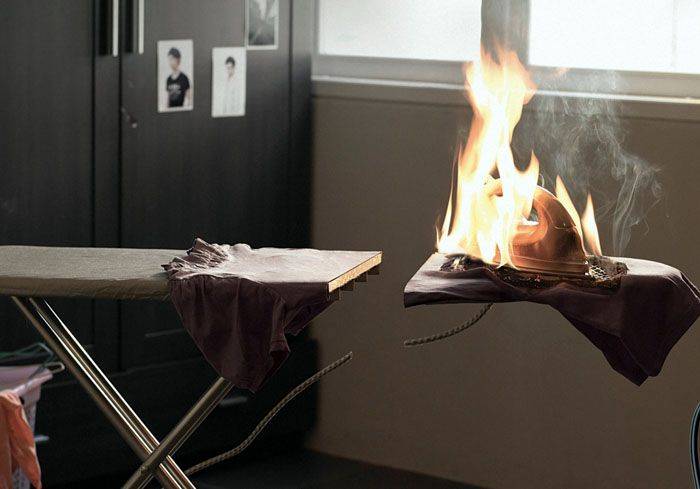
Last but not least, remember to turn off the appliance after work. After all, this very reason can lead at least to being late for work.
Save time: select articles by mail every week
A mixture of citric acid, baking soda and vinegar
To prepare the mixture, you will need citric acid, soda and vinegar.
- Prepare a small container.Pour 2 tablespoons of citric acid, 2 tablespoons of baking soda, and 1 tablespoon of vinegar into it. Mix all ingredients thoroughly.
- You do not need to heat the iron before cleaning.
- Soak a rag liberally in the product and spread it on a plastic bag.
- Place the iron, soles down, on a rag and leave for an hour.
- After that, use a sponge to clean the softened burn from the ironing surface.
- Use toothpicks or cotton swabs to clean the steam holes.
After cleaning, rinse the soleplate with clean water and dry with a dry cloth.
Preventive measures
In order for the need for "general" cleaning of the iron to arise as rarely as possible, simple measures should be taken to prevent the appearance of carbon deposits and scale:
- Set the correct temperature regime depending on the type of material. When ironing delicate materials and wool, cover the items with gauze or cotton.
- Use purified or distilled water depending on the manufacturer's recommendations.
- Activate the self-cleaning function two to three times a month.
- Wipe the iron with a damp towel after each use
The cleanliness of the iron is not only an aesthetic requirement. An appliance whose holes are covered with limescale and the sole of which is soiled with carbon works less efficiently and spoils things. It can be cleaned using industrial and home remedies.
It is important to act carefully and take into account the features of the work surface. Cleaning should be carried out regularly, in this case it is easier to get rid of dirt.
Share this
Class
Share this
Tweet
Zapin
Cleaning the soleplate of the iron
The soleplate of the iron needs regular cleaning. Brown or black spots form on the surface over time. This carbon deposit is the result of melting and burning under the influence of high temperatures of plastic fittings, wool, silk, synthetics, and mixed materials.
Never use metal brushes, a knife, sandpaper or other abrasive materials when cleaning the sole. This can aggravate the situation, and soon the iron will simply have to be thrown away.
Why does it burn
The main cause of burn-in is improper operation.
- Inconsistency of the set temperature with the type of fabric: if a synthetic thing is ironed with an excessively hot iron, fibers will stick to its sole.
- Carelessness in the ironing process, for example: in case of accidental contact with some types of appliqués on clothes, buttons and other plastic parts.
- Pouring tap water into the steam generator. Chlorine and other elements contained in this water contribute to the formation of limescale in the tank itself and in the steaming holes on the sole.
How to protect the sole
Check the labels on the garment beforehand for the recommended ironing temperature. Be sure to set the desired values on the iron thermostat.
Pour only filtered (distilled, bottled) water into the reservoir of the steam generator or use special means to soften its hardness.
Be sure to drain off any remaining liquid after steam ironing.
Wait for the iron to cool completely, then wipe the soleplate with a dry soft cloth and store it in a safe place, safe from the point of view of accidental drops, chips, deformation.
Soda recipes
- Without additives. Dissolve 5 tbsp. l. soda in a glass of lukewarm water. After dampening a cloth (or cotton pad) in the solution, thoroughly rinse the slightly cooled soleplate of the turned off iron. This recipe is suitable for even the most demanding ceramic and Teflon coatings.
- With vinegar. Mix 2 tsp. soda with a small amount of vinegar essence to form a paste with the consistency of thick sour cream. Apply the product to a slightly warm sole and wipe thoroughly with a cloth. In this way, you can clean any type of soleplate of the appliance.
- With toothpaste.Mix equal proportions of toothpaste and baking soda. Apply the mixture to a heated metal or ceramic soleplate, which is then scrubbed with an old toothbrush or soft woolen cloth.
At the end of any of the above procedures, wipe the cover of the iron first with a damp sponge to avoid streaks, and then with a dry cloth.
The better a cleaning pencil
From the point of view of chemistry, soda is sodium bicarbonate (acidic sodium salt of carbonic acid). It contains carbon dioxide, water and up to 37% alkali. Any contamination, even the most persistent, in an alkaline environment is easily destroyed and removed from the surface.
A special pencil for cleaning the iron in the shape of a miniature candle is the advertised product. But it has its drawbacks:
- It contains abrasive particles, therefore, it cannot be called absolutely safe, especially for fragile ceramic and Teflon coatings.
- The composition includes ammonium nitrate, citric and adipic acids. Ammonium nitrate - ammonium nitrate, which is widely used in agriculture, and is explosive at the same time. Environmental friendliness and safety in question!
- When cleaning the iron with a pencil, as opposed to soda, an unpleasant pungent odor is emitted.
- Prices: from 50 to 500 rubles per piece. At the same time, one pencil may not be enough (it usually takes 2/3 of the product to remove one old stain from the sole of the device).
How to clean the soleplate of an iron
Vinegar and ammonia. To carry out the procedure, you will need a rough cloth, 9% vinegar and a small amount of ammonia. So, open the windows to ventilate the room, soak an old towel in vinegar and try to remove dirt from the sole of the turned off appliance. Of course, to do this, you need to rub with effort, and also often soak a rag in vinegar. For greater efficiency, some housewives recommend adding ammonia to the vinegar. When the sole surface is clean, iron the unwanted fabric.
Soda and detergent. Mix 1 tsp. l of baking soda with dishwashing detergent so that you get a homogeneous gruel. After that, apply it evenly with a sponge on the sole of the appliance and wait 5-10 minutes. After the specified time has elapsed, take a damp cloth and begin to rub the sole vigorously until you see your reflection on it. When the carbon deposits are completely removed, wipe the iron with a dry cloth.
Hydrogen peroxide. Just dampen a small piece of cotton wool with this product and carefully wipe the surface of the appliance. Some people recommend using nail polish remover or acetone instead of peroxide. However, this must be done very carefully so that the contained chemical particles do not fall on the plastic part of the iron.
Indelible pencil. You can remove carbon deposits on the sole with an inexpensive special tool. Rub the heated soleplate of the appliance with a chemical pencil purchased from a hardware store and wait for a while. When the applied product has softened the carbon deposits, take a soft, lint-free cloth and wipe it off with a gentle motion. This is a very simple and possibly the most effective way to clean the soleplate of your iron effortlessly. We also note that the substances that are released during this procedure are absolutely safe for health. When the appliance is completely cool, wipe the base with a cloth dampened with water.
Hydroperite. If you don't have a chemical pencil in your home, you can use hydroperite to fix the problem in question. You will need two tablets to completely clean your iron. So, warm up the electrical appliance, rub the sole with this preparation and wait 30-40 minutes. After the specified time has elapsed, remove the dirt with a damp cloth. When the iron has cooled down, wipe it dry with a cloth.
Toothpaste.Practice shows that with toothpaste you can clean not only your teeth, but also the sole of the iron, on which plaque has formed. Simply apply a small amount of toothpaste to the warm base of the appliance, rub with an old toothbrush that you no longer use, and leave it on for 25-30 minutes. After that, rinse everything with warm water and wipe the iron dry with a cloth.
Attention: in this way you can only clean irons with a metal coating (aluminum, steel). The Teflon surface may be damaged and the iron will be damaged.
Finely ground salt
Do not clean Teflon-coated electrical appliances using the following method: sprinkle a thick layer of salt on a clean sheet of paper or an old waste cloth, then warm up the electrical appliance to be cleaned and run it over the salt layer as if you were ironing clothes. Do this while trying to press on the iron, otherwise you will not see the result. For cleaning, we recommend using "Extra" salt, and for greater efficiency, mix it with crushed candle paraffin. When the appliance has completely cooled down, wipe the clean soleplate first with a damp cloth and then with a dry towel.
Laundry soap. This is a very old and simple method that people used when there were no special cleaning products in stores. Immediately after ironing the clothes, they rubbed the sole of the iron with laundry soap and, when it cooled down, washed off the dirt with a damp cloth.
Self-cleaning function
Currently, on store shelves, you can find various brands and models of irons: the most expensive with all sorts of functions, and the cheapest with a minimum of features. Before you start using the appliance, it is worth familiarizing yourself with the enclosed instruction manual. Some modern models of irons have a self-cleaning function. Perhaps your iron has such an option. It is believed that this function cleans well the area of the steam holes.
Of course, if a piece of fabric is stuck to the sole of the iron or there are old accumulations of burn-on, then the self-cleaning function will no longer help. But if you carry out the procedure after each ironing, then there will be no problems with cleaning the working surface of the electrical appliance in the future.


